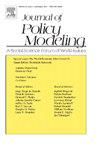地缘经济碎片化时代的国际贸易与经济增长
IF 3.1
2区 经济学
Q1 ECONOMICS
引用次数: 0
摘要
本文采用全信息极大似然法估计的联立方程模型,研究了地缘经济碎片化时代(2017-2023)国际贸易与经济增长的关系。这项研究涵盖了132个国家(30个发达国家和102个发展中国家),并分别分析了大型和小型经济体的贸易增长动态。研究结果证实,贸易仍然是经济增长的一个关键因素,但它更多的是一种促进因素,而不是直接驱动因素。在发达国家,出口对资本形成和增长有正向贡献,工业化对出口有显著贡献,而资本流入对固定资本形成有负向影响。对发展中国家来说,工业化极大地促进了出口,进而带动了经济增长。研究强调,地缘经济碎片化时期保护主义抬头和贸易中断可能削弱贸易对增长的积极影响。通过动态模拟验证了结果,强调了在分散的全球经济中保持增长的战略工业化和贸易伙伴关系的必要性。本文章由计算机程序翻译,如有差异,请以英文原文为准。
International trade and economic growth in the era of geoeconomic fragmentation
This paper studies the relationship between international trade and economic growth during the era of geoeconomic fragmentation (2017–2023), using a simultaneous equations model estimated through the full information maximum likelihood method. The study covers 132 countries (30 advanced and 102 developing) and also analyzes trade-growth dynamics separately for large and small economies. The findings confirm that trade remains a crucial factor for economic growth, but it acts more as a facilitator than a direct driver. In advanced countries, exports positively contribute to capital formation and growth, and industrialization contributes significantly to exports, while capital inflows have a negative effect on fixed capital formation. For developing countries, industrialization significantly boosts exports and in turn economic growth. The study highlights that the rise in protectionism and trade disruptions during the geoeconomic fragmentation period may weaken the positive impact of trade on growth. The results are validated through dynamic simulations, underscoring the need for strategic industrialization and trade partnerships to sustain growth in a fragmented global economy.
求助全文
通过发布文献求助,成功后即可免费获取论文全文。
去求助
来源期刊

Journal of Policy Modeling
ECONOMICS-
CiteScore
6.20
自引率
11.40%
发文量
76
期刊介绍:
The Journal of Policy Modeling is published by Elsevier for the Society for Policy Modeling to provide a forum for analysis and debate concerning international policy issues. The journal addresses questions of critical import to the world community as a whole, and it focuses upon the economic, social, and political interdependencies between national and regional systems. This implies concern with international policies for the promotion of a better life for all human beings and, therefore, concentrates on improved methodological underpinnings for dealing with these problems.
 求助内容:
求助内容: 应助结果提醒方式:
应助结果提醒方式:


